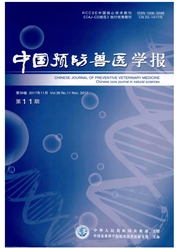

 中文摘要:
中文摘要:
为了解猪瘟病毒(CSFV)在我国的流行情况,本研究对2015上半年来自4个省疑似猪瘟(csF)病料样品采用RT.PCR方法进行检测,28份样品中14份为CSFV阳性,并对这些阳性样品进行CSFVE2基因遗传进化分析。结果表明,14个病毒株中11个属于2.1d新基因亚型,它们与CSFV代表株Shimen、HCLV和2.1b基因亚型病毒株的核苷酸同源性分别为82.8%~84.1%、81.1%~82.4%和92.6%~97.1%,氨基酸同源性分别为89.8%~91.2%、88.2%~89.8%和94.1%~98.9%,其余3个病毒株属于2.1b亚型。这些2.1d亚型新分离株在E2基因的4个氨基酸(R31、S34、K303和A331)上具有相同的分子特征。本研究结果与我们2014年CSFV流行病学研究结果一致,表明2.1d亚型病毒株已成为我国现阶段CSFV的主要流行株。
 英文摘要:
英文摘要:
To investigate the prevalence of classical swine fever virus (CSFV) in China, twenty-eight clinical samples were collected in pigs from suspected CSFV-infected farms in 4 provinces (Shandong, Hebei, Jilin and Heilongjiang) of China in early 2015 which were subjected to detection and identification of subgenotype CSFV. The results showed 14 of the 28 samples were positive for CSFV, and E2 gene sequences of the 14 CSFVs were sequenced, aligned and analyzed, of which the 11/14 CSFVs in 2015 belonged to the 2.1d subgenotype, and 3/14 belonged to the 2.1b subgenotype. In addition, compared with the Shimen, HCLV and the 2. lb subgenotype CSFV strains, the nucleotides similarity of the 11 new 2. ld subgenotype CSFVs were 82.8% to 84.1%, 81.1% to 82.4% and 92.6% to 97.1%, and similarity of the deduced amino acids were 89.8% to 91.2%, 88.2% to 89.8% and 94.1% to 98.9%, respectively. Furthermore, 2. l d subgenotype CSFVs was of the same molecular characteristics, which were R31, S34, K303 and A331 in E2 gene. The study results were consistent with the related study in 2014. Importantly, the results suggested that 2. ld subgenotype of CSFVs had become the major prevalent strains of CSFV in China.
 同期刊论文项目
同期刊论文项目
 同项目期刊论文
同项目期刊论文
 期刊信息
期刊信息
